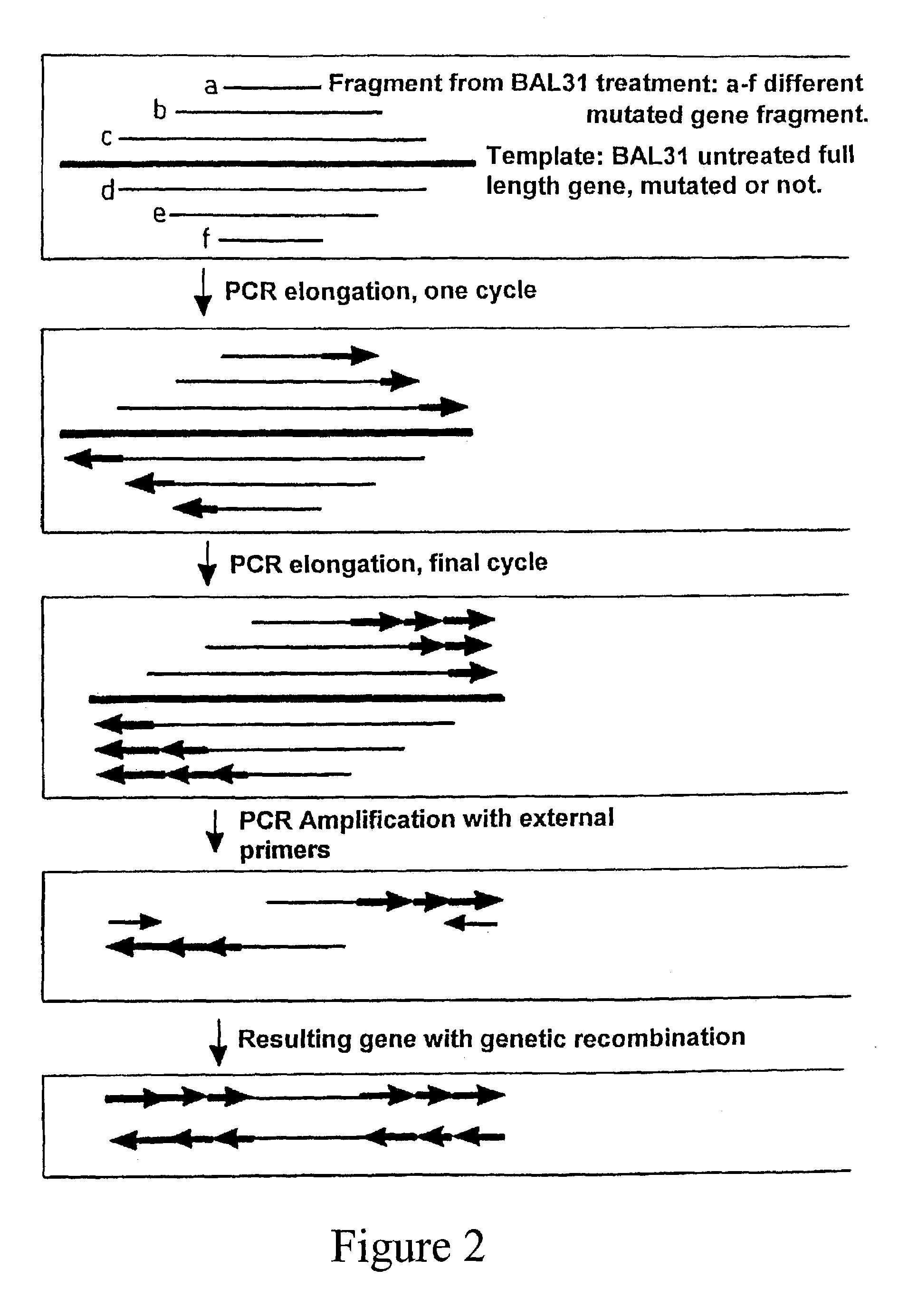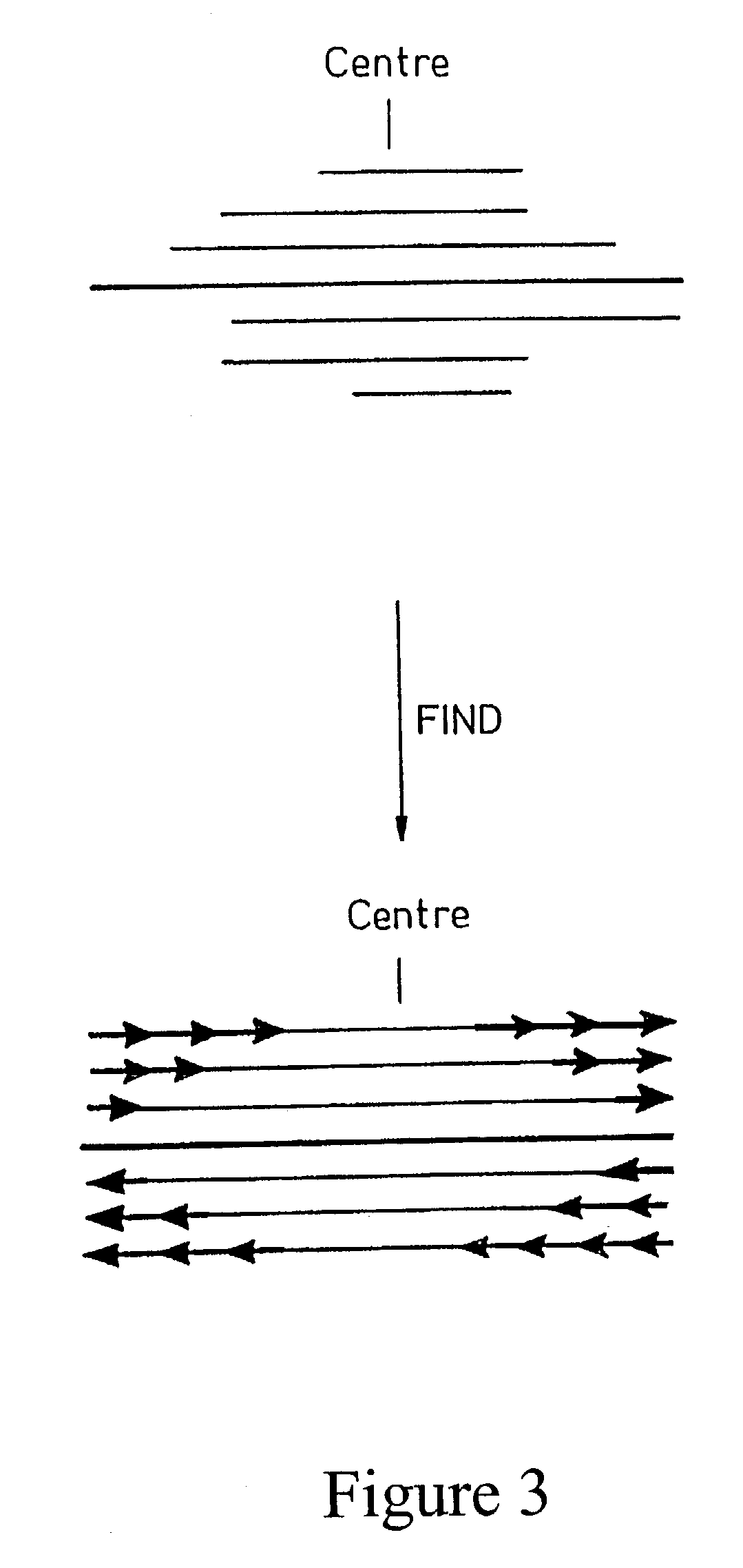Method for in vitro molecular evolution of protein function involving the use of exonuclease enzyme and two populations of parent polynucleotide sequence
a technology of exonuclease and protein, which is applied in the field of in vitro molecular evolution of protein function, can solve the problems of inability to combine two strategies at the same time, inability to shuffling between genetically different clones, and inability to produce non-functional genes
- Summary
- Abstract
- Description
- Claims
- Application Information
AI Technical Summary
Benefits of technology
Problems solved by technology
Method used
Image
Examples
experiment i
Find
Generation of FIND-fragments for BAL31 Nuclease Digestion.
[0105]PCR-fragment of FIND 1 and FIND 3 were generated by running PCR-reactions with FIND 1 and FIND 3-plasmids as templates (500 ng) and with the two external primers, pBR322 HindIII forward primer and pBR322-EagI-reversed-primer. PCR-cycles were as described above for 30 cycles. The amplified PCR-products were mixed with 20 μl of loading buffer (25% Ficoll and Bromophenolic blue) and analyzed on a 2% agarose gel. The electrophoresis was run at 90V for 35 minutes as previously described. Bands of appropriate size were cut out and gel-purified using the Qiaquick Gel Extraction Kit. The DNA-concentration was estimated to 112.25 μg / ml for the FIND-1 PCR-fragment and to 110 μg / ml for the FIND-3 PCR-fragment.
BAL31 Nuclease Treatment:
[0106]5 μg each of FIND 1 and FIND 3 PCR-fragments (FIGS. 7 A and B) were mixed in equimolar amounts together with 100 μl of 2× BAL31 buffer and 10 μl sterile water to a final volume of 200 μl. A ...
experiment ii
Find
[0119]The above described methods were used for a second BAL31 Nuclease treatment with a mixture of 5 μg of FIND 1 and 5 μg of FIND 3 as described above and in the overview in FIG. 1. This time new PCR-fragments had been generated with the estimated concentrations of 192.25 μg / ml for FIND 1 and 231.5 μg / ml for FIND 3. The following reaction mixture was used: 26 μl FIND 1, 21.6 μl FIND 3, 100 μl 2× BAL31 exonuclease buffer, 9.9 μl BAL31 Nuclease and water to 200 μl. A blank was also prepared with 13 μl FIND 1 and 10.8 μl FIND 3, 361 μl 2× BAL31 exonuclease buffer, 0 μl BAL31 Nuclease and water to 72 μl.
[0120]The BAL31 digestion was performed as described in the previous experiment and samples were withdrawn at the same timepoints to tubes with 200 mM EGTA to get a final concentration of 20 mM EGTA. The exonuclease in the resulting samples was heat-inactivated as described above and the fragments where extracted, precipitated and 50% were loaded on agarose gel. After the anticipat...
experiment iii
Find
[0126]The FIND procedure is not restricted to usage with tetracycline genes, but can be applied to any type of gene which encodes a protein or protein motif. This is exemplified by creating a new repertoire of antibody fragments with mutations evenly spread over the entire antibody variable genes after FIND treatment.
[0127]Single base pair mutations were introduced into the VL and VH-regions of the anti-FITC scFv antibody fragment B11 (Kobayashi et al., Biotechniques September 1997; 23(3):500–503) by the use of error prone PCR in accordance with Kuipers et al., (Nucleic Acids Res Aug. 25, 1991; 19(16):4558) except for a raise in the MgCl2 concentration from 2 mM to 5 mM. This anti FITC scFv antibody fragment was constructed by the use of overlap extension PCR, and the overlap extension procedure has previously been used for the random combination of DNA variation (Soderlind et al. Gene Jul. 28, 1995;160(2):269–272).
[0128]The mutated products were then subjected to controlled deg...
PUM
| Property | Measurement | Unit |
|---|---|---|
| Fraction | aaaaa | aaaaa |
| Fraction | aaaaa | aaaaa |
| Fraction | aaaaa | aaaaa |
Abstract
Description
Claims
Application Information
 Login to View More
Login to View More - R&D
- Intellectual Property
- Life Sciences
- Materials
- Tech Scout
- Unparalleled Data Quality
- Higher Quality Content
- 60% Fewer Hallucinations
Browse by: Latest US Patents, China's latest patents, Technical Efficacy Thesaurus, Application Domain, Technology Topic, Popular Technical Reports.
© 2025 PatSnap. All rights reserved.Legal|Privacy policy|Modern Slavery Act Transparency Statement|Sitemap|About US| Contact US: help@patsnap.com



